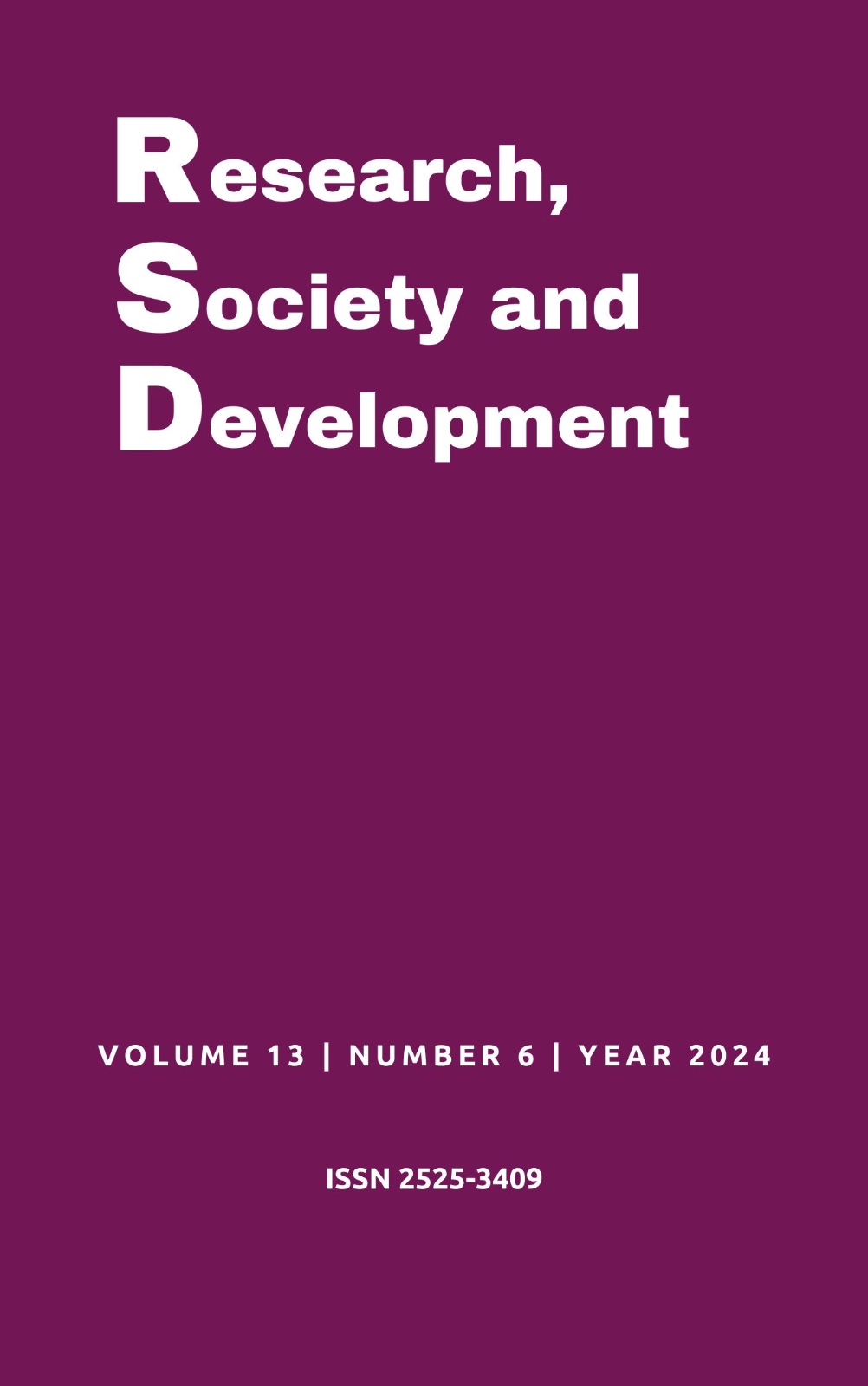Sickle beta zero thalassemia and acute chest syndrome in pediatric: Case report
DOI:
https://doi.org/10.33448/rsd-v13i6.46016Keywords:
Sickle cell trait, Hemoglobin S, Beta Thalassemia, Acute chest syndrome, Heterozygous.Abstract
The objective of this article is to report the case of a 5-year-old male patient diagnosed with Sickle Beta Zero Thalassemia. An inherited disease that affects the hemoglobin of red blood cells, causing the formation of hemoglobin S (sickle cell) and thalassemia. The presence of "zero" indicates the absence of normal hemoglobin in the blood. This condition leads to the sickle-shaped deformation of red blood cells, making their circulation in blood vessels difficult, generating complications, including acute chest syndrome. It is possible to recognize this rare disease by its clinical presentation and with the help of the laboratory. A diagnosis was established in the patient based on clinical findings such as diagnostic images, complete blood count, peripheral blood smear and hemoglobin electrophoresis and subsequent evaluation by the pediatric hematology specialist. Clinical genetics is increasingly relevant in today's medicine, and it is essential that primary care (PC) professionals become familiar with its concepts. The correct identification of these patients ensures adequate genetic counseling and the implementation of regular clinical controls. This allows for early preventive intervention and addressing health problems before they fully develop.
References
Alghamdi, F. A., Al-Kasim, F., Alshhada, F., Ghareeb, E., Azmet, F. R., Almudaibigh, A., & Alluqmani, R. (2024). Risk factors for acute chest syndrome among children with sickle cell anemia hospitalized for vaso-occlusive crises. Scientific Reports, 14(1). https://doi.org/10.1038/s41598-023-48527-1
Bender, M. A., Carlberg, K., Adam, M. P., Feldman, J., & Mirzaa, G. M. (2003, 15 de septiembre, actualizado 2023, 28 de diciembre). Sickle cell disease. En M. P. Adam, H. H. Ardinger, R. A. Pagon, et al. (Eds.), GeneReviews [Internet]. University of Washington, Seattle.
Brandow, A. M., & Liem, R. I. (2022). Advances in the diagnosis and treatment of sickle cell disease. Journal of Hematology & Oncology, 15(1). https://doi.org/10.1186/s13045-022-01237-z
Cela, E., Beléndez, C., & Galarón, P. (2009). Interpretación de la electroforesis de hemoglobina. Anales de Pediatría Continuada, 7(3), 152–155. https://doi.org/10.1016/s1696-2818(09)71119-9
Dunlop, R., & Bennett, K. C. (2014). Pain management for sickle cell disease in children and adults. The Cochrane Library, 2019(6). https://doi.org/10.1002/14651858.cd003350.pub3
González-Pérez, C., Gómez-Carpintero García, A., & Cervera Bravo, Á. (2022). Influencia de la hidroxiurea en la gravedad de los episodios de síndrome torácico agudo en pacientes con drepanocitosis. Anales de Pediatría (Barcelona, Spain: 2003), 97(1), 63–65. https://doi.org/10.1016/j.anpedi.2021.08.006
Jameson, J. L., Loscalzo, J., Kasper, D. L., Longo, D. L., Fauci, A. S., & Hauser, S. L. (2022). Harrison principios de medicina interna (21a ed.). McGraw Hill.
Kirkham, J. K., Estepp, J. H., Weiss, M. J., & Rashkin, S. R. (2023). Genetic variation and sickle cell disease severity: A systematic review and meta-analysis. JAMA Network Open, 6(10), e2337484. https://doi.org/10.1001/jamanetworkopen.2023.37484
NCBI. (s/f). HBA2 hemoglobin subunit alpha 2 [Homo sapiens (human)] - Gene. Recuperado el 26 de mayo de 2024, de https://www.ncbi.nlm.nih.gov/gene/3040
NCBI. (s/f). HBB hemoglobin subunit beta [Homo sapiens (human)] - Gene. Recuperado el 26 de mayo de 2024, de https://www.ncbi.nlm.nih.gov/gene/3043
Nicklaus Children's Hospital. (s/f). Beta 0 talasemia drepanocítica. Recuperado el 26 de mayo de 2024, de https://www.nicklauschildrens.org/condiciones/beta-0-talasemia-drepanocitica
Panyasai, S., Fucharoen, G., & Fucharoen, S. (2015). Known and new hemoglobin A2 variants in Thailand and implication for β-thalassemia screening. Clinica Chimica Acta; International Journal of Clinical Chemistry, 438, 226–230. https://doi.org/10.1016/j.cca.2014.09.003
Rezende, P. V., Santos, M. V., Campos, G. F., Vieira, L. L. M., Souza, M. B., Belisário, A. R., & Viana, M. B. (2018). Clinical and hematological profile in a newborn cohort with hemoglobin SC. Jornal de Pediatria, 94(6), 666–672. https://doi.org/10.1016/j.jped.2017.09.010
Sans-Sabrafen, J. (2006). Hematología clínica (5a ed.). Elsevier.
Secretaría de la Organización Mundial de la Salud. (s/f). Talasemia y otras hemoglobinopatías. Recuperado el 26 de mayo de 2024, de https://apps.who.int/gb/ebwha/pdf_files/EB118/B118_5-sp.pdf
TBH Creative. (s/f). Acute chest syndrome. Recuperado el 26 de mayo de 2024, de https://www.ihtc.org/acute-chest-syndrome
Vacca, V. M., Jr, & Blank, L. (2017). Drepanocitosis: situación actual y perspectivas. Nursing, 34(6), 32–39. https://doi.org/10.1016/j.nursi.2017.11.010
Valiente, M. R. (s/f). Síndrome torácico agudo en niño con drepanocitosis. Revista Electrónica de Portalesmedicos.com. Recuperado el 26 de mayo de 2024, de https://www.portalesmedicos.com/publicaciones/articles/2224/1/Sindrome-toracico-agudo-en-nino-con-drepanocitosis.html
Wahed, A., Quesada, A., & Dasgupta, A. (2020). Hemoglobinopathies and thalassemias. En Hematology and Coagulation. Elsevier.
Ware, R. E., de Montalembert, M., Tshilolo, L., & Abboud, M. R. (2017). Sickle cell disease. Lancet, 390(10091), 311–323. https://doi.org/10.1016/s0140-6736(17)30193
Downloads
Published
Issue
Section
License
Copyright (c) 2024 Diego Fernando López Muñoz; Juan Esteban Grisales Domínguez; Nicolás Delgado Garcés; Valeria Llanos Posso; Camilo Arellano Genoy; Olga Patricia Ortiz Corrales

This work is licensed under a Creative Commons Attribution 4.0 International License.
Authors who publish with this journal agree to the following terms:
1) Authors retain copyright and grant the journal right of first publication with the work simultaneously licensed under a Creative Commons Attribution License that allows others to share the work with an acknowledgement of the work's authorship and initial publication in this journal.
2) Authors are able to enter into separate, additional contractual arrangements for the non-exclusive distribution of the journal's published version of the work (e.g., post it to an institutional repository or publish it in a book), with an acknowledgement of its initial publication in this journal.
3) Authors are permitted and encouraged to post their work online (e.g., in institutional repositories or on their website) prior to and during the submission process, as it can lead to productive exchanges, as well as earlier and greater citation of published work.


